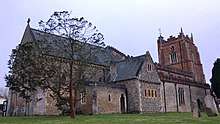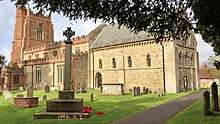Castle Hedingham
Castle Hedingham is a village in northeast Essex, England, located four miles west of Halstead and 3 miles south-east of Great Yeldham in the Colne Valley on the ancient road from Colchester, Essex, to Cambridge.
| Castle Hedingham | |
|---|---|
 St. James Street, Castle Hedingham, Essex | |
 Castle Hedingham Location within Essex | |
| Population | 1,201 (2011)[1] |
| OS grid reference | TL787357 |
| District | |
| Shire county | |
| Region | |
| Country | England |
| Sovereign state | United Kingdom |
| Post town | Halstead |
| Postcode district | CO9 |
| Dialling code | 01787 |
| Police | Essex |
| Fire | Essex |
| Ambulance | East of England |
| UK Parliament | |
It developed around Hedingham Castle, the ancestral seat of the de Veres, Earls of Oxford. The first earl, Aubrey de Vere III, finished the initial building of the keep and established a Benedictine nunnery, Castle Hedingham Priory, near the castle gates. Hugh de Vere, fourth earl of Oxford, purchased the right to hold a market in the town of the crown in the mid-13th century. He also founded a hospital just outside the gates of the castle around 1250.
The village's main attractions are the well preserved Norman Hedingham Castle, the Colne Valley Railway, Kirby Hall and its many timber-framed medieval buildings.
The church of St. Nicholas is late Norman and Gothic, building having commenced around 1180. The fine double hammerbeam roof is attributed to Thomas Loveday, who was responsible for work on St John's College, Cambridge. Its Romanesque wheel window and cemetery cross are remnants of the Norman church.


The village was served by Sible and Castle Hedingham railway station which was opened by Colne Valley & Halstead Railway Company in 1867. The station closed in 1964 and was dismantled and rebuilt in 1974 on a new site to the north west of the village by the Colne Valley Railway Preservation Society.
Castle Hedingham Pottery was an art pottery studio run by Edward Bingham at Castle Hedingham from about 1864 until 1901.
Notable residents
- Edward Bingham, Victorian potter whose Castle Hedingham Ware has become increasingly sought after.
- Margery Blackie, doctor of medicine who was appointed as the first woman royal physician to Queen Elizabeth II.
- Sir Fowell Buxton, 1st Baronet, founder of the RSPCA, Member of Parliament and social reformer who was a leading abolitionist in the 19th century and took over William Wilberforce's leadership of the anti slavery movement in the House of Commons when the latter retired.
- Mark Catesby, naturalist.
- Aubrey de Vere I, holder of the entire manor of Hedingham (later Castle Hedingham) in the Domesday Book of 1086.
- Aubrey de Vere III, 1st Earl of Oxford, completed the stone keep at Hedingham.
- Robert de Vere, 3rd Earl of Oxford, one of the 25 barons of Magna Carta.
- Robert de Vere, 9th Earl of Oxford.
- John de Vere, 13th Earl of Oxford, commander of Henry Tudor's army at the Battle of Bosworth Field.
- Major-General Daniel Hoghton, British Army officer who served during the Napoleonic Wars with distinction.
- Anne Lindsay, actor and Jack Lindsay, Australian writer.[2]
- James Majendie, Conservative Party politician.
- Lewis Majendie, Conservative Party politician.
- Musette Majendie, owner of Hedingham Castle.
- Eric Ravilious, painter, book illustrator and wood engraver.
References
- "Civil Parish population 2011". Neighbourhood Statistics. Office for National Statistics. Archived from the original on 19 October 2016. Retrieved 1 September 2016.
- "Davies, Ann Lorraine [known as Ann Lindsay] (1914–1954), actress and translator | Oxford Dictionary of National Biography". www.oxforddnb.com. doi:10.1093/ref:odnb/68985. Retrieved 15 April 2019.
External links
| Wikimedia Commons has media related to Castle Hedingham. |
- SEAX Archaeology - Unlocking Essex's Past (archived from the original on 3 June 2016). An in-depth essay about Castle Hedingham.
- Hedingham School
- A brief history of the village
